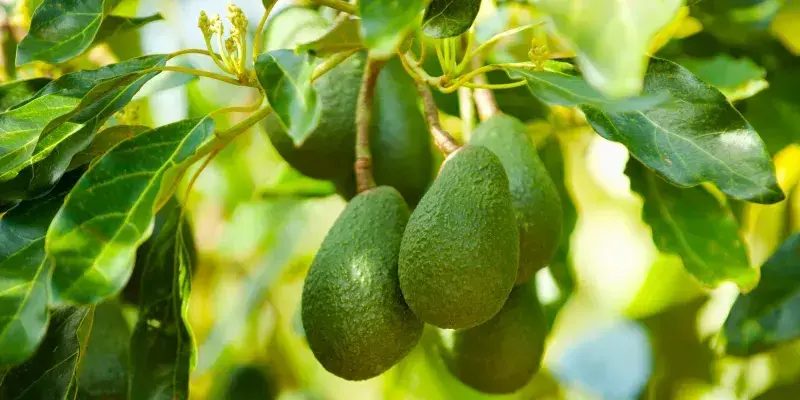
Appearance:
Shape: Most commonly pear-shaped, but varieties can also be round or egg-shaped.
Size: Varies greatly by cultivar, from small (hen's egg size) to very large (up to 1 kg or more).
Skin: The skin varies widely depending on the variety:
Hass (most common globally): Thick, pebbly, and dark green when unripe, turning purplish-black as it ripens.
Fuerte: Smooth, thin, glossy green skin that remains green even when ripe.
Other varieties: Can have green, brown, or even reddish skin, with textures ranging from smooth to heavily wrinkled.
Flesh: The edible flesh is typically pale green to golden-yellow near the skin, transitioning to a lighter, more buttery yellow towards the large central seed.
Flavor Profile & Aroma:
Taste: Avocados have a distinctively mild, nutty, and buttery flavor. Unlike most fruits, they are not sweet or tart. Their taste is subtle and can be enhanced by seasoning (e.g., salt, lime juice).
Aroma: A very mild, earthy, and slightly nutty aroma.
Texture:
Flesh: When ripe, the flesh is incredibly creamy, smooth, and almost melt-in-your-mouth, often described as having a "buttery" consistency. It lacks the juiciness of typical fruits.
Firmness: Avocados are typically harvested when firm and unripe. They soften significantly as they ripen. A ripe avocado will yield slightly to gentle pressure.
The Seed:
Avocados contain a single, large, round to oval-shaped seed or "pit" in the center, which is not edible. It can account for a significant portion of the fruit's weight.
Nutritional Value & Health Benefits:
Often hailed as a "superfood," avocados are remarkably nutrient-dense.
Healthy Fats: Rich in monounsaturated fatty acids (primarily oleic acid), which are considered "good" fats that can help lower bad cholesterol (LDL) and promote heart health.
Vitamins: Excellent source of Vitamin K, Vitamin C, Vitamin E, Vitamin B6, and Folate.
Minerals: High in Potassium (often more than a banana), Magnesium.
Fiber: A good source of dietary fiber, aiding digestion and promoting satiety.
Antioxidants: Contain various antioxidants, including lutein and zeaxanthin, beneficial for eye health.
Low in Sugar: Unlike most fruits, avocados are very low in sugar.
Culinary Uses:
Avocados are incredibly versatile in the kitchen, primarily used in savory dishes, but also in some sweet preparations.
Guacamole: The most famous use, where mashed avocado is combined with lime juice, onion, cilantro, and chili.
Salads: Sliced or diced avocado adds creaminess and healthy fats to salads.
Toast: Smashed or sliced on toast, often with seasonings.
Smoothies: Adds a creamy texture and richness to smoothies.
Sandwiches/Wraps: A great addition for texture and nutrition.
Salsas: Enhances the flavor and texture of fresh salsas.
Desserts: Increasingly used in healthy desserts like chocolate mousse (where its fat content creates a silky texture) or ice cream.
Avocado Oil: Extracted for its healthy fats and mild flavor, used in cooking and dressings.
Seasonality in Kerala, India:
While avocados are not a major commercial crop in India, limited cultivation exists in southern states like Kerala, Tamil Nadu, Karnataka, and Maharashtra, as well as in Sikkim in the Northeast.
In Kerala, avocados thrive in the humid tropical climate, particularly in regions like Wayanad.
Harvesting periods can vary by variety, but in Kerala, some varieties are ready for harvest from early April through September. There can be multiple flowering seasons depending on the cultivar.
However, due to increasing demand, avocados are also imported to ensure year-round availability in markets like Kochi.
In essence, the avocado is a unique, creamy, and highly nutritious fruit, cherished for its mild, buttery flavor and remarkable versatility in a wide array of culinary applications.

